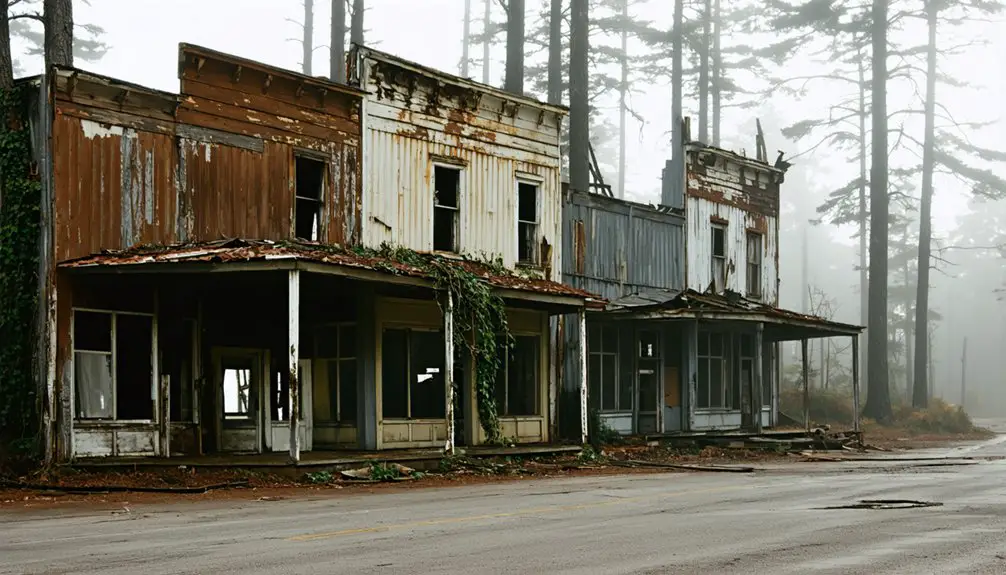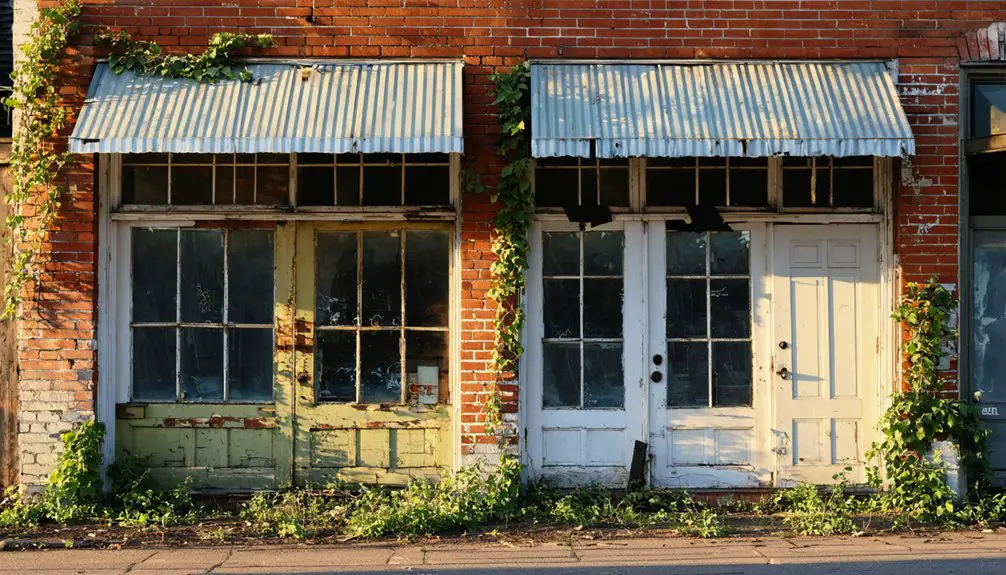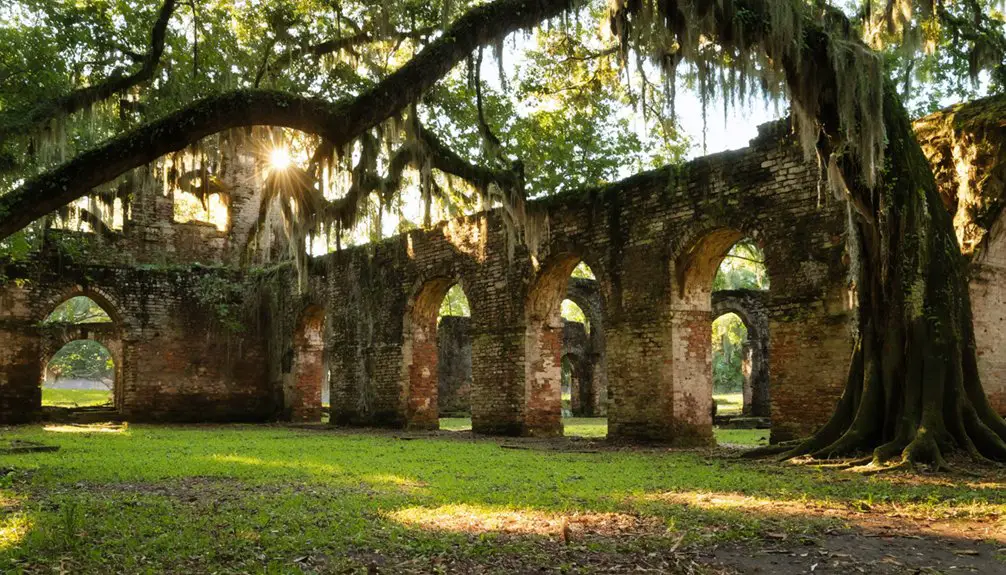You’ll discover Diamond City’s remarkable story as a thriving maritime settlement on North Carolina’s Shackleford Banks, established in the 1760s and named for Cape Lookout Lighthouse’s distinctive diamond pattern. By the 1890s, this bustling coastal community of 500 residents relied on fishing and whaling for survival. However, devastating hurricanes in 1896 and 1899 forced residents to abandon their homes, leading to a mass exodus that transformed Diamond City into the ghost town it remains today.
Key Takeaways
- Diamond City was a thriving coastal settlement near Cape Lookout Lighthouse, named after the lighthouse’s distinctive black-and-white diamond pattern in 1885.
- The community reached its peak in the 1890s with 500 residents, sustaining itself through fishing, whaling, and maritime activities.
- Devastating hurricanes in 1896 and 1899, with winds up to 140 mph, destroyed homes and contaminated water sources.
- The entire community abandoned the settlement following severe storms, with most residents relocating to nearby Harkers Island.
- Today, Diamond City exists only as protected burial grounds and cultural memories, preserved through annual homecoming events and museum exhibits.
The Rise of a Coastal Settlement
While Diamond City’s origins were humble, beginning as an unnamed settlement known simply as “the eastern end,” its strategic location on Shackleford Banks would shape its destiny as a thriving maritime community.
From humble beginnings as the eastern end, Diamond City’s position on Shackleford Banks forged its maritime legacy.
You’ll find the settlement’s roots dating back to the 1760s, when a settler named Davis built the first permanent house in what was then called Lookout Woods.
The community’s strategic position, about a mile west of Cape Lookout Lighthouse and protected by a 40-foot dune, made it ideal for maritime pursuits.
The local community developed around sand hill dominance, with homes strategically positioned on the dunes.
By 1885, the settlement adopted the name “Diamond City,” inspired by the lighthouse’s striking black-and-white diamond pattern.
The coastal geography proved perfect for fishing and whaling operations, transforming this once-unnamed outpost into the largest community on Cape Banks, with 500 residents by the 1890s.
Local residents made their living through fishing and clamming activities that sustained their seafood-based diet.
Life by the Cape Lookout Lighthouse
The towering Cape Lookout Lighthouse stood as the beating heart of Diamond City’s maritime community, its distinctive black and white diamond pattern serving as both a lifeline for sailors and a symbol of local pride.
During the Civil War, Confederate raiders sought to sabotage the lighthouse and its precious first-order Fresnel lens was removed to Raleigh for safekeeping. The lighthouse sustained damage during this period, leading to the installation of a temporary third-order lens.
You’d find the lighthouse keepers living in the converted 1812 tower, tending to the essential tasks of maritime navigation day and night. They’d climb the 163-foot spiral staircase to maintain the Fresnel lens, which could guide ships up to 19 miles offshore through the treacherous Cape Lookout Shoals.
Every 15 seconds, the light would flash, warning vessels of danger. When automation arrived in 1950, it marked the end of an era where these dedicated keepers had manually operated the beacon that had protected countless sailors since 1859.
A Community Built on Maritime Resources
At its height, Diamond City thrived as a bustling maritime hub where nearly 500 residents built their lives around the bounty of surrounding waters.
You’d find skilled craftsmen like Macajah ‘Cagie’ Adams perfecting their boatbuilding craftsmanship, while others mastered diverse fishing techniques from oyster harvesting to net fishing in the rich coastal waters. Many families demonstrated remarkable resilience by dismantling their homes and sailing them to new locations when conditions deteriorated.
The series of hurricanes forced residents to abandon their beloved coastal home by 1905, ending an era of maritime prosperity.
The community’s self-sufficient spirit showed in their maritime expertise:
- Year-round fishing operations adapted to seasonal changes in local waters
- Residents crafted their own boats, fishing gear, and maritime equipment
- Skilled boatbuilders earned reputations that extended to nearby Morehead City
Life centered on the Cape Lookout Lighthouse, which guided vessels through treacherous shoals and shaped the community’s identity – even inspiring the town’s diamond-patterned namesake.
Nature’s Fury: The Hurricane Years
You’ll find the story of Diamond City’s downfall in the devastating hurricanes of 1896 and 1899, which brought unprecedented destruction through massive storm surges and winds up to 140 mph.
These “monster storms” destroyed homes, drowned livestock, contaminated wells with saltwater, and even disturbed graves, leaving the tight-knit community in shock and disarray. The hurricane’s fury eroded the giant protective dune that had run through the heart of Diamond City.
Hurricane San Ciriaco caused complete devastation of fishing equipment in the affected towns. The hurricanes’ brutal impact ultimately forced residents to abandon their island home, with many families relocating to nearby Harkers Island to preserve their cultural bonds while rebuilding their lives away from the vulnerable shore.
Devastating Storms Strike Back
During the late 19th century, Diamond City faced a relentless barrage of hurricanes that would ultimately seal its fate. Despite the community’s deep-rooted coastal resilience, you’ll find that nature’s fury proved overwhelming between 1878 and 1899, when five major hurricanes ravaged Cape Banks. Most residents relocated to Harkers Island after abandoning their homes. The salvaged shipwreck timber that built their original homes couldn’t withstand the powerful storms.
Storm preparedness couldn’t match the sheer force of these disasters, particularly the devastating August 1899 hurricane.
The storms’ impact manifested in three critical ways:
- Maritime forests declined as sand dunes advanced inward, destroying natural barriers.
- Erosion transformed the landscape, making the area increasingly uninhabitable.
- Local fishing and whaling industries collapsed, undermining the community’s economic foundation.
Nature Reclaims The Land
While Diamond City’s residents struggled against the hurricanes’ immediate devastation, nature’s gradual reclamation of their homeland proved equally unstoppable.
You’d have witnessed sand slowly creeping over once-green areas as maritime forests declined, making the land increasingly hostile for human habitation. The loss of essential vegetation that had stabilized the landscape accelerated this transformation.
Nature’s reclamation manifested through dramatic changes: coastal grasses and scrub overtook abandoned streets, while wildlife, including wild horses, returned to claim the emptied spaces.
The ecological restoration brought new patterns of sediment distribution and saltwater intrusion, reshaping waterways and wetlands.
Though you’ll still find old graveyards marking human presence, the landscape has largely returned to its wild state, with only scattered traces remaining of the once-thriving community.
The Great Migration to Safer Shores
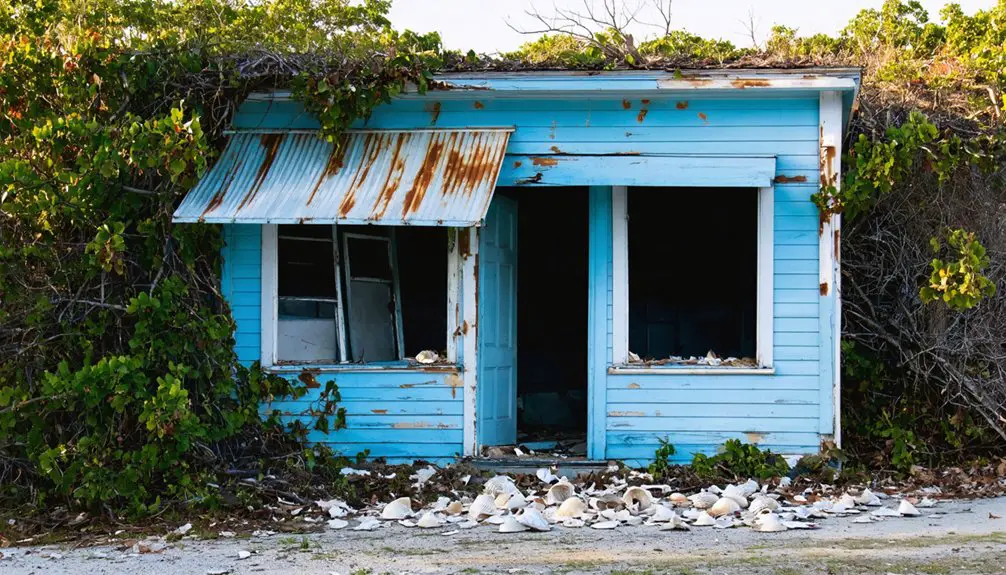
You’ll find that Diamond City’s residents, facing devastating storms and an uncertain future, joined the broader pattern of African American migration from North Carolina’s coast during the early 1900s.
As entire families left their island homes behind, they often relocated together to establish new communities in mainland areas they deemed safer from hurricanes.
These displaced islanders brought their maritime traditions and close community bonds with them as they built new lives in places like Morehead City, Beaufort, and other coastal settlements.
Mass Exodus After Storms
As devastating hurricanes battered Diamond City between 1878 and 1899, its resilient community of 500 residents finally reached their breaking point.
You’ll find their community resilience evident in how they orchestrated a remarkable mass exodus, physically moving entire houses to safer mainland locations.
The migration patterns revealed their determination to preserve their way of life:
- Families relocated together, maintaining close social bonds as they settled primarily in Harkers Island and Morehead City.
- Within just two years, Harkers Island’s population surged from 28 to 200 families.
- Residents continued their maritime traditions, returning seasonally to Diamond City’s waters for fishing and whaling until 1909.
Building New Island Communities
Since the early 2000s, island communities have embraced extensive development strategies that prioritize both population growth and climate resilience.
You’ll find these communities adapting to projected population increases through careful island expansion that incorporates mixed-income housing and enhanced infrastructure.
Your new island neighborhoods aren’t just about building homes – they’re designed with community resilience in mind.
Legislative frameworks like House Bill 1220 and 1181 guarantee you’ll have access to housing at all income levels while protecting against climate threats.
Strategic planning relocates developments away from vulnerable areas, incorporating natural buffers and elevated structures.
You’ll see thorough plans that balance growth with environmental protection, supported by improved transportation networks and utilities.
It’s a forward-thinking approach that preserves both your freedom and safety in these evolving coastal spaces.
Preserving Diamond City’s Heritage
While Diamond City no longer exists as a physical settlement, its rich heritage lives on through dedicated preservation efforts spanning historical documentation, cultural traditions, and community gatherings.
You’ll find the community’s spirit preserved through oral histories, family artifacts, and annual homecoming events that connect descendants to their ancestral roots.
Heritage preservation takes many forms:
- Museums and historians commemorate key anniversaries and maintain exhibits that tell Diamond City’s story.
- Family burial plots and tombstones on Shackleford Banks remain protected as hallowed ground.
- Traditional fishing practices, boatbuilding skills, and maritime customs continue through generations.
Through careful stewardship and cultural continuity, you’re witnessing how Diamond City’s legacy endures in surrounding communities like Harkers Island and Morehead City, where descendants maintain their unique customs and maritime heritage.
Environmental Changes and Their Impact
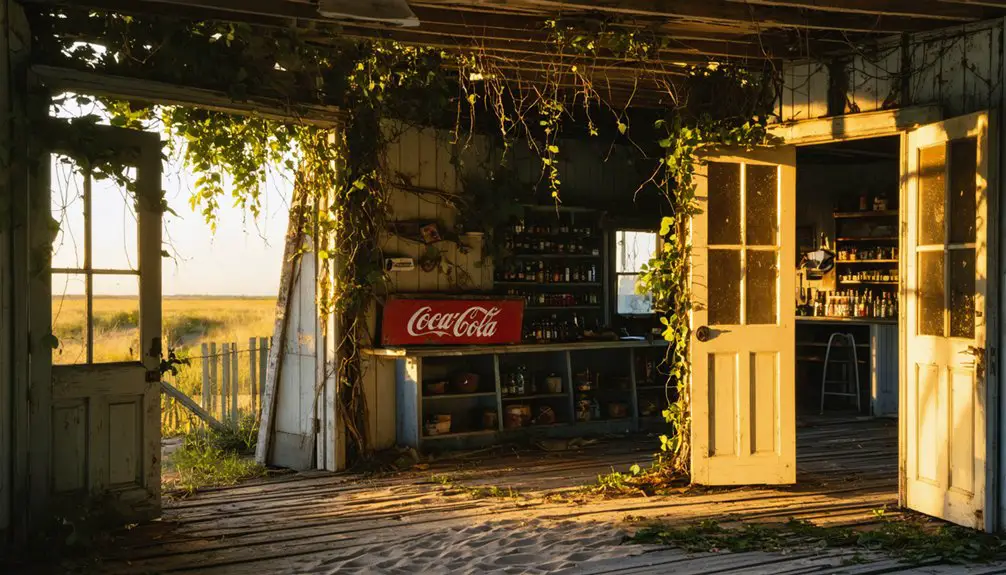
Through a devastating series of hurricanes between 1878 and 1899, Diamond City faced environmental challenges that would ultimately seal its fate.
You’ll find that these storms triggered a cascade of environmental degradation, weakening the maritime forest that had long protected the settlement. As the natural barriers failed, massive sand dunes up to 20 feet high began burying homes and vegetation, while increasing saltwater intrusion killed off freshwater-dependent trees, creating eerie “ghost forests” along the coast.
The community’s coastal resilience was further compromised by shifting plant communities and deteriorating soil conditions.
Daily Life in a Seafaring Town
At its peak in the late 19th century, Diamond City thrived as a bustling maritime community of nearly 500 residents, making it the largest settlement on the Cape Banks.
You’d find families teaching their children essential fishing techniques and maritime education, passing down generations of seafaring knowledge that guaranteed survival along these challenging shores.
Life revolved around the sea’s rhythms, with daily activities centered on:
The ocean’s pulse guided their existence, shaping each day’s work and purpose in this maritime community.
- Hunting whales and catching mullet and porpoises in small sailing vessels
- Building and maintaining boats, with craftsmen like “Cagie” Adams leading construction efforts
- Salvaging shipwrecks during storms while managing household needs with well water and modest crops
The tight-knit community lived in simple wooden homes built on sand, sharing both the bounty and hardships of coastal living through their maritime-focused lifestyle.
Legacy of the Lost Settlement
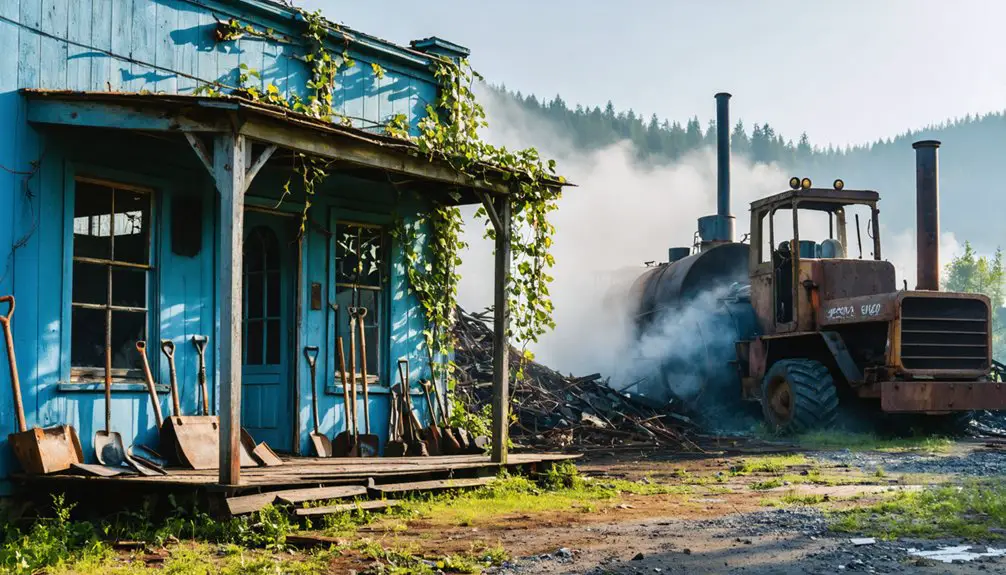
The legacy of Diamond City lives on through its resilient descendants, who maintain strong connections to their maritime heritage despite the settlement’s abandonment over a century ago.
You’ll find their cultural continuity expressed through annual Diamond City Homecoming celebrations and cherished family oral histories passed down through generations.
The community’s maritime craftsmanship endured long after residents relocated to Harkers Island and Morehead City.
Traditional skills like whalebone needle-making and specialized boat-building techniques continued to flourish in these new locations.
Notable craftsmen like Macajah ‘Cagie’ Adams emerged from these transplanted families.
While the physical town has vanished beneath shifting sands, its influence remains vibrant through the descendants who’ve preserved their ancestors’ seafaring traditions, making the story of Diamond City more than just a tale of abandonment.
Frequently Asked Questions
What Happened to the Furniture and Belongings Left Behind in Diamond City?
You’ll find most residents relocated their belongings and furniture, while anything left behind deteriorated from storms, sand coverage, and harsh maritime elements, leaving minimal traces of household items today.
Were There Any Schools or Formal Education Systems in Diamond City?
You’d find a basic education system with schoolteacher Bettie Gillikin Adams leading classes, though the community structure relied more on informal, family-based learning of trades and traditional skills.
Did Diamond City Residents Have Any Unique Dialect or Local Language?
You won’t find clear evidence of a unique dialect, though local expressions likely existed. While dialect variations might have developed from maritime life, they weren’t documented before residents dispersed to nearby communities.
What Types of Medical Care Were Available to Diamond City Residents?
You’d have relied mainly on home remedies and community care, with minimal healthcare services available. No permanent medical practitioners existed in town, forcing you to travel mainland for serious treatment.
How Did Residents Communicate With Mainland Communities and Receive Mail Services?
You’d rely on ferry services and private boats to carry mail and messages to the mainland, since there weren’t any telegraph lines. Family networks helped maintain communication through regular visits and seasonal contacts.
References
- https://coastalreview.org/2024/08/museum-to-mark-125th-anniversary-of-cae-bankers-exodus/
- https://cabinculturesobx.com/2024/08/06/diamond-city-a-homecoming/
- https://wcti12.com/news/local/descendants-remember-lost-down-east-community
- https://northcarolinaghosts.com/coast/the-ghost-lights-of-dymond-city/
- http://daresociety.blogspot.com/2009/07/another-ghost-town-diamond-city.html
- https://coastalreview.org/2019/08/event-set-to-honor-diamond-citys-legacy/
- https://www.nps.gov/parkhistory/online_books/calo/calo_clvggh_hsr.pdf
- https://www.nps.gov/calo/learn/historyculture/lhouse_timeline.htm
- https://www.outerbankslighthousesociety.org/capelookout-1.html
- https://en.wikipedia.org/wiki/Cape_Lookout_Lighthouse
